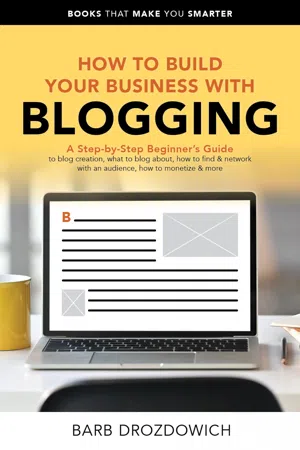
How To Build Your Business With Blogging
A Step-by-Step Beginner's Guide to blog creation, what to blog about, how to find & network with an audience, how to monetize & more
- English
- ePUB (mobile friendly)
- Available on iOS & Android
How To Build Your Business With Blogging
A Step-by-Step Beginner's Guide to blog creation, what to blog about, how to find & network with an audience, how to monetize & more
About This Book
Are you hoping to build your business – grow your audience - using blogging?
Have you considered blogging as a method of connecting with the existing audience of a small business?
Technical trainer Barb Drozdowich has been blogging since 2010. She has grown her 3 primary blogs to host thousands of visitors each day. She understands how to build an audience and how to build a business using blogging. She supports her family using money earned from her blogs.
One of the best ways to connect with an audience and grow an audience is through the use of a blog. A blog can provide entertainment or provide education. A blog can show that you are the "go-to" person for information in your niche.
Do you feel uncertain about the technology or what to blog about?
How to Build your Business with Blogging is aimed at a beginner to intermediate audience. Barb teaches not only how to set up a blog, but how to turn it into a money-making tool of communication with your audience. She brings several decades of teaching experience and common everyday language to what many see as a complicated subject. In this book you'll discover:
How blogging can help to build and improve communication with an audience
How to create powerful topics to blog about that generate shareable content and grow your audience
How to create optimized blog posts that will get people talking
How to maintain, protect & backup your content to keep your site safe for years to come
How to monetize a blog and how to understand the actions of your audience
Through a series of short & easy to follow chapters, How to Build Your Business with Blogging helps you choose the right platform, understand the technical aspects & get started today.
If you like an easy-to-understand book that cuts through the technobabble that exists in many tech manuals, this book is for you! Pick up this great deal today & start blogging right away!
Frequently asked questions
Information
What is Blogging
Why do I need to blog?
Branding
Table of contents
- Cover
- Title Page
- Dedication
- Contents
- Introduction
- 1. What is Blogging
- 2. Why do I need to blog?
- 3. Branding
- 4. What do I blog about?
- 5. Common Blogging Myths
- 6. Let’s all speak the same language
- 7. The Blog Platform – How to Choose
- 8. Upfront Costs and Hidden Costs
- 9. Basic Contents of a Blog
- 10. Parts and Pieces of a Blog Post
- 11. Ideal Structure of a Blog Post
- 12. Tags & Categories
- 13. Plugins & Widgets
- 14. Sidebars
- 15. Automation
- 16. Copyright
- 17. Understanding Stats
- 18. How to Monetize a Blog
- 19. Using Affiliate Links
- 20. FTC Statement
- 21. Backing up and Updating
- 22. Networking – How to find and expand your audience
- 23. 25 Proactive Ways to expand your reach
- 24. Being More Social
- 25. Conclusion
- Technical Help
- Sources of Pictures for Blog Posts
- Glossary
- Your Helpful Hints are Waiting
- About the Author
- Also by Barb Drozdowich